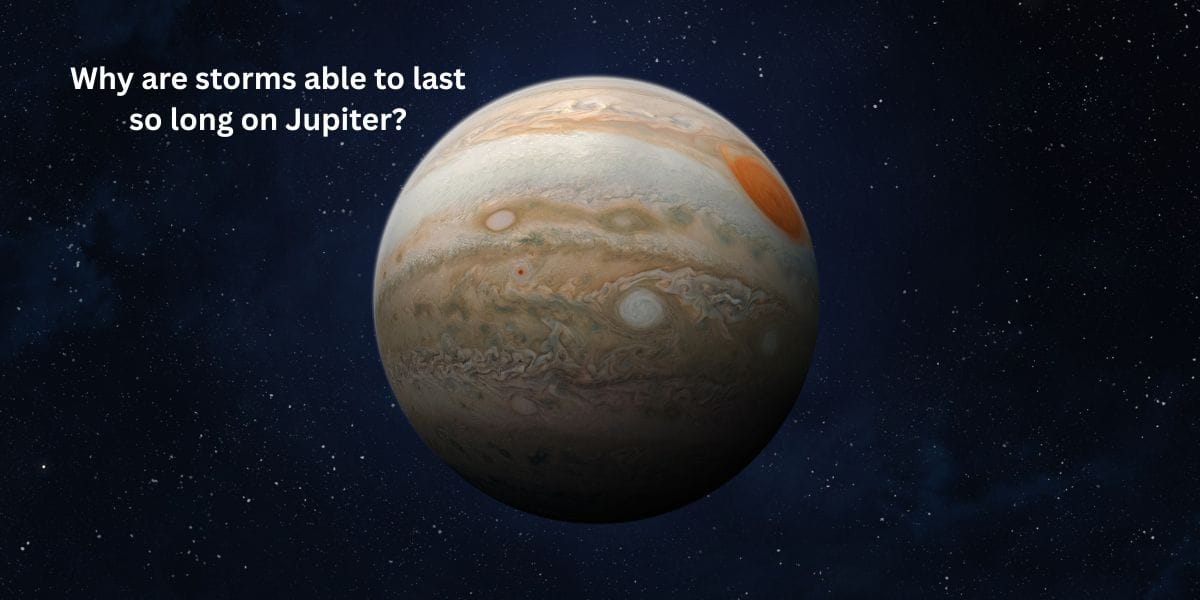Jupiter’s swirling atmosphere is a masterpiece of cosmic chaos, streaked with vibrant bands and storms that dwarf our entire planet. That famous Great Red Spot? It’s a hurricane-like monster twice Earth’s width that’s been churning for centuries. While terrestrial storms fade in days, Jupiter’s tempests rage on endlessly, powered by the gas giant’s furious rotation and seething internal heat.
Why does this happen? Jupiter is not like Earth. It has no solid ground, just thick layers of gas. The planet spins super fast, and its storms feed off endless energy. But how can a storm last for centuries? Let’s find out!
What Makes Jupiter’s Storms Different from Earth’s Storms?
Storms on Earth need warm water and air to form. When they hit land or cold areas, they lose power and fade away. But Jupiter has no land—just a deep, churning atmosphere.
- No solid surface: Earth’s storms weaken when they hit mountains or land. Jupiter’s storms keep spinning because there’s nothing to stop them.
- Fast winds: Jupiter spins faster than any other planet. This keeps the winds moving nonstop, fueling storms for years.
- Endless energy: Jupiter’s atmosphere has heat rising from inside the planet, keeping storms alive much longer.
Imagine stirring a cup of tea. On Earth, the spoon (land) stops the swirl. On Jupiter, there’s no spoon—just endless spinning!
Why Does the Great Red Spot Never Disappear?
The Great Red Spot is Jupiter’s most famous storm. It’s bigger than Earth and has been around since at least the 1600s!
- Size matters: Big storms lose energy slower. The Great Red Spot is so huge that it takes a very long time to weaken.
- No friction: On Earth, storms rub against the ground and slow down. Jupiter’s storm floats freely in the atmosphere.
- Constant energy supply: Jupiter’s heat and winds keep feeding the storm, like adding wood to a fire.
Scientists think the Great Red Spot might shrink one day, but for now, it’s still going strong!
How Does Jupiter’s Fast Spin Affect Storms?
Jupiter is the fastest-spinning planet in our solar system. One day on Jupiter lasts only about 10 hours!
- Strong winds: Fast rotation creates powerful jet streams, which help storms grow.
- No seasons: Jupiter’s tilt is small, so the weather doesn’t change much. Storms don’t get disrupted like on Earth.
- Stable paths: Storms get trapped in wind bands, moving in the same direction for years.
Think of a spinning top—the faster it spins, the longer it stays up. Jupiter’s speed keeps its storms alive!
Do Other Planets Have Long-Lasting Storms Too?
Yes! Jupiter isn’t the only planet with long storms.
- Neptune has the Great Dark Spot, a storm that lasted for years before fading.
- Saturn has giant hexagonal storms at its poles.
- Venus has fast winds that create never-ending cloud patterns.
But Jupiter’s storms are the biggest and longest-lasting we know of!
Could a Storm Like Jupiter’s Happen on Earth?
No—Earth’s conditions are very different.
- We have land: Storms break apart when they hit continents.
- Slower spin: Earth’s rotation isn’t strong enough to keep storms going for centuries.
- Less heat: Earth doesn’t have the same internal heat as Jupiter to fuel storms.
If a storm like the Great Red Spot formed on Earth, it would disappear quickly.
Will Jupiter’s Storms Ever Stop?
Some storms on Jupiter do fade away, but new ones form all the time. The Great Red Spot is shrinking slowly, but it might last many more years.
- New storms appear: Smaller storms merge and grow bigger.
- Energy never runs out: Jupiter’s atmosphere keeps feeding storms.
Scientists watch Jupiter closely to learn more about its amazing weather!
Conclusion
Jupiter’s storms last so long because the planet has no land, spins fast, and has endless energy. The Great Red Spot is like a giant whirlpool that never stops! While Earth’s storms come and go, Jupiter’s storms rage on for centuries.
📌 Frequently Asked Questions
How big is Jupiter’s Great Red Spot?
The Great Red Spot is about 1.3 times wider than Earth! It’s so big that three Earths could fit inside it.
Why is the Great Red Spot red?
Scientists aren’t completely sure, but they think chemicals like sulfur and phosphorus in Jupiter’s clouds give it a reddish color.
Can we see Jupiter’s storms from Earth?
Yes! With a good telescope, you can see Jupiter’s stripes and sometimes the Great Red Spot.
Does Jupiter have lightning?
Yes! Jupiter has powerful lightning storms, much stronger than on Earth.
How long has the Great Red Spot existed?
It has been observed since at least the 1600s, meaning it’s over 400 years old!
What would happen if you flew into Jupiter’s storm?
The winds are deadly fast, and the pressure would crush anything. No spacecraft could survive inside!
Is Jupiter’s Great Red Spot getting smaller?
Yes, it has been shrinking slowly over the past 100 years, but it’s still enormous.
Does Jupiter have hurricanes like Earth?
Jupiter has giant swirling storms, but they work differently because there’s no ocean.
What is Jupiter made of?
Mostly hydrogen and helium gas, with a possible rocky core deep inside.
Could Jupiter’s storms ever reach Earth?
No! Jupiter is too far away, and its storms can’t leave the planet’s atmosphere.
